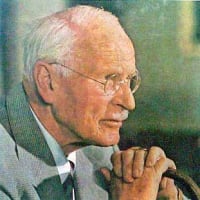
https://www.facebook.com/groups/309050616982953/user/100054253791045/
Գոհար Մնացականյան 分析心理学 理論と実践
あなたがたのために、今日、ダビデの町に救い主、すなわち主キリストがお生まれになったのである。
- ルカによる福音書』2章11節
彼[キリスト]は私たちの中におられ、私たちは彼の中にいます。彼の国は、高価な真珠、野に埋められた宝、大木となる一粒のからし種、そして天の都です。
キリストが私たちのうちにおられるように、その天の御国もまた私たちのうちにあるのです。
キリストは自己の元型を体現している。キリストは神的あるいは天的な全体性(「あらゆる点ですべてを満たす方の満ち満ちた状態」エペソ1:23)、栄光の人、「罪の汚れのない」神の子、罪によって汚されていない人を表しています。堕落前の最初のアダムはまだ純粋な神の像であり、テルトゥリアヌスはこのアダムについて次のように述べています。オリゲンはもっとはっきりしている。肉体ではなく魂に刻印されたイマーゴ・デイ(神の像)は像の像である。"私の魂は直接神の像ではなく、以前の像に似せて作られたからである"。
一方、キリストは神の真の姿であり、その似姿に倣って私たちの内なる人は造られ、目に見えず、体もなく、腐敗せず、不死である。私たちの中の神像は、"prudentia, iustitia, moderatio, virtus, sapientia et disciplineina"(先見性、正義、節度、勇気、知恵、規律)を通じて明らかにされます。
聖アウグスティヌスは、キリストである神像と、神のようになるための手段あるいは可能性として人間に植え付けられる像を区別している。
神像は肉体的な人間の中にあるのではなく、「理性的なアニマ」の中にあり、その所有が人間を動物から区別している。
[理性的な魂、すなわち心と意志の座は、人間と動物に共通する食欲と感覚的知覚の力である「アニマ・イラショナリス」(アニマ非合理性)と対比される]。「神像は内なるものであって、肉体の中にあるのではない。理解力のあるところ、心のあるところ、真理を究明する力のあるところに、神はその姿を現すのである」。したがって、私たちは神の像に似せて造られているのは、理解力のあるところ以外のどこにもないことを思い出すべきだと、アウグスティヌスは言うのです。"しかし人は自分が神の形に似せて作られたことを知るとき、自分の中に獣に与えられている以上のものがあることを知る"
このことから、神のイメージはいわば「アニマ・ルーシス」(アニマ合理性)と同一であることが明らかである。後者は聖パウロの言う「ホモ・コエレスティス」(天上人)であり、より高次の霊的な人間である。[最初の人は地上のものであり、地上のものであり、二番目の人は天上のものであり、天上のものである。]
堕落前のアダムと同様に、キリストは神像の体現者であり、その全体性は聖アウグスティヌスによって特に強調されている。「この神像の全体性は、聖アウグスティヌスによって特に強調されている。「みことばは、完全な人間性、すなわち人間の魂と肉体を身につけた。さらに正確に言うならば、野の獣でさえ「魂」と「体」を持っているのだから、私が人間の魂と人間の肉と言ったのは、完全な人間の魂を身にまとったということである。人間の中の神像は堕落によって破壊されたのではなく、ただ傷つき堕落した(「変形した」)だけであり、神の恵みによって回復することができるのである。
この統合の範囲は、「descensus ad inferos」、(地獄への降下)すなわちキリストの魂が地獄に降下し、その救済の業が死者をも包含することによって示唆されている。心理学的には、集合的無意識の統合がこれに相当し、個性化のプロセスの本質的な部分を形成している。
聖アウグスティヌスは、「それゆえ、我々の目的は我々の完成でなければならないが、我々の完成はキリストである」と述べている。このため、キリストは "王 "とも呼ばれる。彼の花嫁(スポンサ)は人間の魂であり、それは「内側に隠された霊的な神秘のうちに御言葉と結合され、二人が一つの肉体となる」もので、キリストと教会の神秘的結婚に対応する。
- C.G.ユング「キリスト、自己の象徴」。CW 9ii: アイオン 自己の現象学への研究、pars.CW 9ii: Aion: Researchches into the Phenomenology of the Self, pars. 69-72.
キリストの生涯は、心理学的な観点から見ると、私たちの中にある個性化に対する無意識的な傾向と同一である。それは、しばしば悲劇的であると同時に英雄的でもある冒険である。誤りと罪がなければ、恵みの経験も、つまり神と人間の結合もないのだ。
- C.G.ユング、ウィリアム・ラシャット牧師への書簡(1955年6月29日)。C.G.ユング書簡集1951-1961、第2巻、p.268。
キリストの心理的な「長所」(というより意義)は、「初子」として、完全な、統合された人間の元型であるという事実にある。このイメージは、歴史が証言しているように、ヌミノースであり、それゆえ、別のヌミノース性によってのみ答えることができるのである。このイメージは、私たちの中にある自己の元型であるイマーゴ・デイ(神の像)に触れて、それを目覚めさせるのです。自己は「星座」化され、そのヌミノース性によって、人間を全体性、すなわち無意識の統合やエゴの全体的な「意志」への従属に向かわせる。
心理学的な意味での完全性とは、人間の完全性ではなく、「完全さ」を意味する。全体性は無意識も包含しているので、意識的であるはずがない。したがって、その少なくとも半分は超越的な状態、神秘的でヌミノースな状態である。
個性化とは、超越的な目標であり、人間の化身(神の性質の受肉)である。
このうち合理的に理解できるのは、意識の全人格的宗教的努力、すなわち無意識の中の全人格的衝動の「レリギオース・オブザーバー」(宗教的観察)だけであり、「キリストにある」ことによって予表される全体性や自己の実存的現実はないのだ。
- C.G.ユング、ヴェルナー・ニーデラー牧師への手紙(1951年3月26日)、14頁。
Art: ミヒャエル・トレビル「ベツレヘムの小さな町よ

キリストの地獄への下降
人が不完全だと感じるのは実際には何ですか?
Գոհար Մնացականյան 分析心理学 理論と実践
For unto you is born this day in the city of David a Saviour, which is Christ the Lord.
- Gospel of Luke, v. 2:11
He [Christ] is in us and we in him. His kingdom is the pearl of great price, the treasure buried in the field, the grain of mustard seed which will become a great tree, and the heavenly city.
As Christ is in us, so also is his heavenly kingdom.
Christ exemplifies the archetype of the self. He represents a totality of a divine or heavenly kind [“the fullness of Him who fills everything in every way,” Ephesians 1:23], a glorified man, a son of God ‘sine macula peccati’ [without a stain of sin], unspotted by sin. As Adam secundus he corresponds to the first Adam before the Fall, when the latter was still a pure image of God, of which Tertullian says: “And this therefore is to be considered as the image of God in man, that the human spirit has the same motions and senses as God has, though not in the same way as God has them.” Origen is very much more explicit: The imago Dei imprinted on the soul, not on the body, is an image of an image, “for my soul is not directly the image of God, but is made after the likeness of the former image.”
Christ, on the other hand, is the true image of God, after whose likeness our inner man is made, invisible, incorporeal, incorrupt, and immortal. The God-image in us reveals itself through “prudentia, iustitia, moderatio, virtus, sapientia et disciplina” [foresight, justice, moderation, courage, wisdom, and discipline].
St. Augustine distinguishes between the God-image which is Christ and the image which is implanted in man as a means or possibility of becoming like God.
The God-image is not in the corporeal man, but in the ‘anima rationalis,’ the possession of which distinguishes man from animals.
[The rational soul, the seat of mind and will, is contrasted with the ‘anima irrationallis,’ powers of appetite and sense-perceptions which are common to humans and animals]. “The God-image is within, not in the body. Where the understanding is, where the mind is, where the power of investigating truth is, there God has his image.” Therefore we should remind ourselves, says Augustine, that we are fashioned after the image of God nowhere save in the understanding: “but where man knows himself to be made after the image of God, there he knows there is something more in him than is given to the beasts.”
From this it is clear that the God image is, so to speak, identical with the ‘anima rationalis.’ The latter is the higher spiritual man, the ‘homo coelestis’ [the celestial man] of St Paul. [“The first man is of the earth and is earthly, the second man is of heaven and is heavenly,” 1st Corinthians 15:47].
Like Adam before the Fall, Christ is an embodiment of the God-image, whose totality is specially emphasized by St. Augustine. “The Word,” he says, “took on complete manhood, as it were in its fulness: the soul and body of a man. And if you would have me put it more exactly, since even a beast of the field has a ‘soul’ and a body, when I say a human soul and human flesh, I mean he took upon him a complete human soul.” The God-image in man was not destroyed by the Fall but was only damaged and corrupted (“deformed”), and can be restored through God’s grace.
The scope of the integration is suggested by the ‘descensus ad inferos,’ the descent of Christ’s soul to hell, its work of redemption embracing even the dead. The psychological equivalent of this is the integration of the collective unconscious which forms an essential part of the individuation process.
St. Augustine says: “Therefore our end must be our perfection, but our perfection is Christ,” since he is the perfect God-image. For this reason he is also called “King.” His bride (sponsa) is the human soul, which “in an inwardly hidden spiritual mystery is joined to the Word, that two may be in one flesh,” to correspond with the mystic marriage of Christ and the Church.
- C.G. Jung, Christ, A Symbol of the Self. CW 9ii: Aion: Researches into the Phenomenology of the Self, pars. 69-72.
The life of Christ is identical in us, from the psychological point of view, with the unconscious tendency toward individuation. That is what forces us to live life completely, an adventure which is often as heroic as it is tragic. Without error and sin there is no experience of grace, that is, no union of God and man.
- C.G. Jung, Letter to Pastor William Lachat (29 June 1955). C.G. Jung Letters 1951-1961, Vol. 2, p. 268.
The psychological “merit” (or rather, significance) of Christ consists in the fact that, as the “firstling,” he is the prototype of the perfect, the integral man. This image, as history testifies, is numinous and can therefore be answered only by another numinosity. It touches the imago Dei, the archetype of the self in us, and thereby awakens it. The self is then “constellated” and by virtue of its numinosity compels man towards wholeness, i.e., towards the integration of the unconscious or the subordination of the ego to a holistic “will,” which is rightly conceived to be “God’s will.”
Perfection in the psychological sense means the “completeness,” not the perfection of man. Wholeness cannot be conscious, since it also embraces the unconscious. Hence at least half of it is a transcendental state, mystical and numinous.
Individuation is a transcendental goal, an incarnation of the man.
The only part of this we can understand rationally is the holistic religious striving of consciousness, i.e., the ‘religiose observare’ of the holistic impulses in the unconscious, but not the existential reality of wholeness or of the self, which is prefigured by ‘being in Christ.’
- C.G. Jung, Letter to Pastor Werner Niederer (26 March 1951), p. 14.
Art: Michael Torevell, O Little Town of Bethlehem
ヌーメン性
1.ヌーメンの、またはヌーメンに関連する; 超自然的。
2.超自然的な存在感で満たされている、または特徴づけられている:ヌミノースの場所。
3.霊的に高められた; 荘厳な。
4.精神的または宗教的な感情を喚起する
5.神秘的または畏敬の念を起こさせるラテン語のヌーメンの神の意志
numinosity(ヌミノース性)という用語は、宗教と人類学の学術研究以外ではあまり知られていません。
ある意味で、ヌミノース性は、より一般的な用語である光度のようなものです。
しかし、ヌミノース性は、月の光度などの外向きに見える光ではなく、微妙で精神的な光を指します。
ヌミノース性と光度は共存するかもしれませんが、それらはどういうわけか異なったままです。
「聖水をまき散らすことはミサの中で最もヌミノースな瞬間でした」
「瞑想の後、ジェニーはしばしば素晴らしいヌミノース性の感情で満たされます。」
Jennifire著2008年10月10日
Numinosity
1. Of or relating to a numen; supernatural.
2. Filled with or characterized by a sense of a supernatural presence: a numinous place.
3. Spiritually elevated; sublime.
4. arousing spiritual or religious emotions
5. mysterious or awe-inspiring Latin numen divine will
The term numinosity isn’t too well-known beyond the academic study of religion and anthropology.
In a sense numinosity is like the more familiar term luminosity.
But numinosity refers to a subtle, spiritual light instead of an outwardly visible light such as the luminosity of the moon.
While numinosity and luminosity may coexist, they remain somehow different.
"The sprinkling of Holy Water was the most numinous moment in the Mass"
"After meditation, Jenny is often filled with great feelings of numinosity."
by Jennifire October 10, 2008
Numinosity
https://www.urbandictionary.com/define.php?term=Numinosity
ヌミノーゼ
https://en.wikipedia.org/wiki/Numinous



















